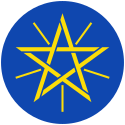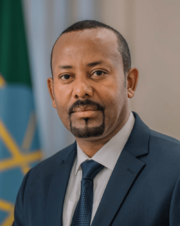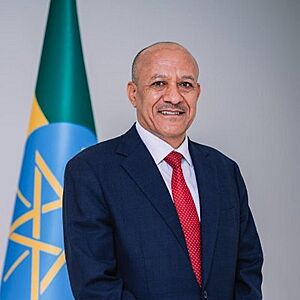Prime Minister of Ethiopia facts for kids
Quick facts for kids Prime Minister of Ethiopia |
|
|---|---|

Flag of Ethiopia
|
|

Emblem
|
|
| Style | Honourable Prime Minister (Within Ethiopia) Prime Minister (Informal) His Excellency (Diplomatic) |
| Abbreviation | PM |
| Member of | Federal Parliamentary Assembly |
| Reports to | House of Peoples' Representatives |
| Residence | Menelik Palace |
| Appointer | House of Peoples' Representatives |
| Term length | 5 years term unless Federal Parliamentary Assembly dissolved sooner No term limits specified |
| Precursor | Chief Minister of Ethiopia |
| Inaugural holder | Habte Giyorgis Dinagde (Chief Minister) Makonnen Endelkachew (Prime Minister) |
| Formation | 1909 (Chief Minister) 1943 (Prime Minister) |
| Deputy | Deputy Prime Minister of Ethiopia |
| Salary | 3,939,808 Ethiopian birr/73,600 USD annually |
The Prime Minister of Ethiopia is like the main leader of the government in Ethiopia. They are in charge of running the country day-to-day. Ethiopia is a parliamentary republic, which means the Prime Minister leads the government and is also the top commander of the Ethiopian Armed Forces.
The Prime Minister is the most powerful political figure in Ethiopia. Their official home is the Menelik Palace in Addis Ababa. The Prime Minister is chosen from the members of the House of Peoples' Representatives. They must get a "vote of confidence" from the House to officially start their job. This means most members agree they are the right person to lead.
Abiy Ahmed is the current Prime Minister. He has been serving since April 2018.
Contents
Understanding the Prime Minister's Role
The Prime Minister is the head of government and the chief executive of Ethiopia. This means they lead the country's daily operations. They also lead the Council of Ministers, which is a group of top government officials.
How the Prime Minister is Chosen
After a general election, the National Election Board of Ethiopia announces the results. The president of Ethiopia then suggests the leader of the party that won the most seats in the House of Peoples' Representatives to become the Prime Minister.
This person is called the Prime Minister Designate. They must be a member of the House of Peoples' Representatives. If no single party wins a clear majority, the president asks the leader of the party with the most votes to try and form a government with other parties.
The Prime Minister Designate needs approval from two-thirds of the House of Peoples' Representatives. Once approved, they take an oath to be loyal to the Constitution and the people of Ethiopia.
History of Ethiopia's Leaders
The role of a main government leader has been used in Ethiopia for a long time. Before modern government, Ethiopia was an absolute monarchy. This meant the King of Kings had all the power.
The idea of a "head of government" started in the late 18th and early 19th centuries. This happened when Emperor Menelik II began to set up modern government systems.
Early Leaders: Chief Ministers (1909–1943)
The first leader at a cabinet level was Habte Giyorgis Dinagde. He was the "chief minister" under Emperor Menelik II. The chief minister led the cabinet and the Ministry of Defense. They served as long as the King of Kings wanted them to.
Other chief ministers included Tafari Makonnen and Betwoded Wolde Tzaddick.
The First Prime Ministers (1943–1974)
The official title of "Prime Minister" was created after the 1931 Constitution of Ethiopia. This was Ethiopia's first modern constitution. It aimed to create a new government system.
The 1931 Constitution said the emperor of Ethiopia was the absolute ruler. The Prime Minister led the council of ministers. This council managed daily government tasks with the emperor's permission.
Makonnen Endelkachew was the first Prime Minister. Later, the 1955 revised Constitution gave more power to the Prime Minister and the Parliament. Even so, the emperor still had a lot of control.
Aklilu Habte-Wold was the first Prime Minister under the 1955 Constitution. The last one was Mikael Imru. He was removed from office during the 1974 revolution.
Military Rule (1974–1987)
In September 1974, the last emperor of Ethiopia, Haile Selassie, was overthrown by a military group. This group was called the Provisional Military Government (PMG). They ended the monarchy.
During this time, there was no Prime Minister. The chairman of the Provisional Military Government was the head of the government.
People's Democratic Republic (1987–1991)
The Prime Minister's office returned with the 1987 Constitution of Ethiopia. This constitution created the People's Democratic Republic of Ethiopia (PDRE). The Prime Minister was the head of government and the main advisor to the president.
Fikre Selassie Wogderess was the first Prime Minister of the PDRE. He served from 1987 to 1989. The last Prime Minister was Tesfaye Dinka.
Transitional Government (1991–1995)
After the Ethiopian Civil War ended in 1991, a new temporary government was formed. This was the Transitional Government of Ethiopia. In this system, the president was the head of state, and the Prime Minister was the head of government.
The Prime Minister was chosen by the president. They led cabinet meetings with the president's advice. Tamrat Layne was the only Prime Minister during this period.
Federal Democratic Republic (1995–Present)
In 1995, a new constitution was created. This made Ethiopia a parliamentary republic. The president of Ethiopia became the head of state, and the Prime Minister became the head of government.
The Prime Minister leads the Council of Ministers. They are also the top commander of the Ethiopian Armed Forces. The Prime Minister is usually the leader of the party with the most seats in the House of Peoples' Representatives.
Meles Zenawi was the first Prime Minister of the Federal Democratic Republic of Ethiopia. He served from 1995 to 2012. The current Prime Minister is Abiy Ahmed, who started in April 2018.
Prime Minister's Security
The Prime Minister of Ethiopia is the most protected government official. Their security team is part of the Republican Guard. This is a special military unit of the Ethiopian National Defense Force.
A special unit called the Counter Military Unit protects the Prime Minister's official home, the Menelik Palace. This unit is highly trained and uses advanced weapons and vehicles.
Deputy Prime Minister of Ethiopia
| Deputy Prime Minister of Ethiopia | |
|---|---|
| Member of | Federal Parliamentary Assembly |
| Appointer | Prime Minister |
| Term length | 5 years |
| Formation | 1995 |
| First holder | Tamrat Layne |
The Deputy Prime Minister helps the Prime Minister. They carry out tasks given to them by the Prime Minister. They also act on behalf of the Prime Minister when the Prime Minister is not available.
See also
 In Spanish: Primer ministro de Etiopía para niños
In Spanish: Primer ministro de Etiopía para niños
- Council of Ministers (Ethiopia)
- Emperor of Ethiopia
- List of emperors of Ethiopia
- President of Ethiopia



